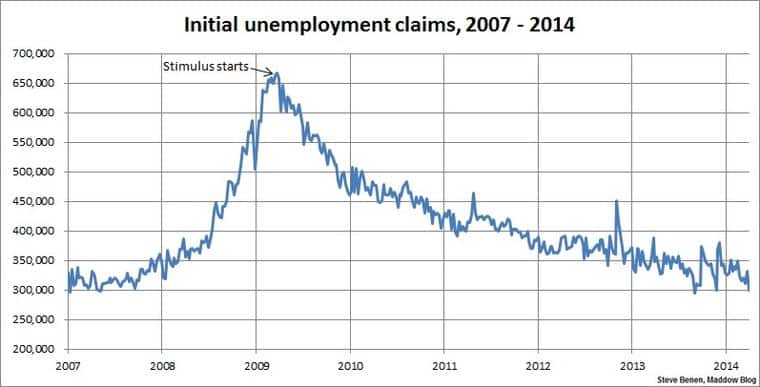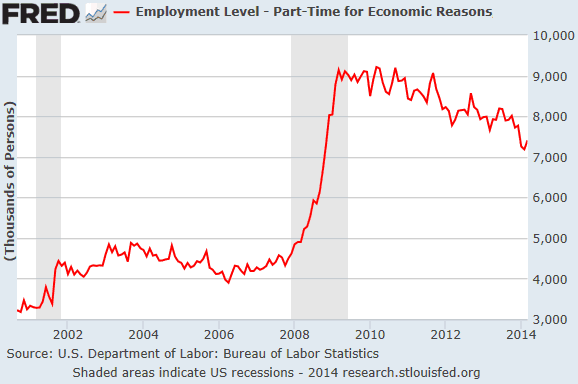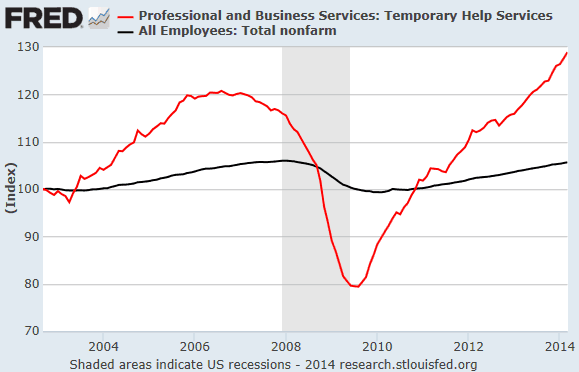Thursday's unemployment applications number hit a 7-year low of (seasonally adjusted) 300,000, a drop of 32,000. We have restored the number of jobs lost in the Great Recession. This is indeed good news.
But even so, things are not rosy in the unemployment numbers – pay is really low and lots of people are really hurting – and Republicans in Congress continue to obstruct all efforts to improve the situation.
Thursday's Number Is Good News
This week's Labor Department report of the number of people applying for new unemployment applications reached a seven-year low, with 300,000 people (seasonally adjusted) applying. This was a drop of 32,000 from the prior week. This chart show why this is good news.

Now The Bad News
Last week's unemployment report for March showed that the economy has finally created enough new jobs to make up for all of the jobs lost after the 2008 Wall Street crash. Unfortunately, that's just catching up to where we were in 2008; that doesn't account for all the new people needing jobs and for the fact that so many of those new jobs pay so much less than the jobs that went away. At the Roosevelt Institute's Next New Deal blog Wednesday, Jeff Madrick explains, in "America Can Attain Full Employment with a Bold Approach to the Jobs Emergency,"
After five long years, the economy has at last produced enough new jobs to compensate for the 8 million lost in the Great Recession of 2009. But in that same period some 7 million more Americans reached employment age, and we have only produced about half the jobs we need to keep up with population growth. To make matters worse, the jobs created during the recovery pay on average much less than those lost.
At Naked Capitalism, Yves Smith posts Wolf Richter discussing two charts that show some of the employment problems we still face. The first is people working part-time who want to work full time:

As this chart shows, a vast number of people are working part time when they want to be working full time. The 2001 recession took it from about 3 million to just under 5 million. It drifted down and briefly touched 4 million, but then even before the Great Recession it was heading back up, and then – wham! – it shot up to 9 million. And now there are still 7.41 million people working in part-time jobs when they want full-time jobs! At the current rate it will take 15 years to get back to where we were before the 2001 recession.
Richter writes:
It’s as if companies had been using the last two recessions as an excuse to make their workforce more flexible, using people only when absolutely needed, on irregular schedules, and keeping them on stand-by the rest of the time. This is a powerful tool in bringing payroll expenses down. It makes the company look awesome on paper. It wreaks havoc on the lives and incomes of workers and is terrible for the overall economy.
The second chart shows temp workers (red) and total nonfarm workers:

After the 2001 recession, hiring was finally kicking in by 2003. The number of temporary workers stood at nearly 2.3 million (out of 130.3 million total nonfarm employees). "By summer of 2006, the number of temps had jumped 17.8% to 2.66 million while total nonfarm employment had risen 4.9% to 136.6 million."
But then the number of temps started to decline. At the time economists thought this was a good sign, that companies were shifting from temps to employees. But what was really happening was that declining demand was hitting businesses – people were not paid enough and were going into debt to pay their bills. The housing bubble was starting to burst.
The second half of this chart shows how our economy has changed. Richter explains:
Temp jobs have simply and relentlessly been rocketing ever higher and hit 2.84 million in March, up 62.4% from the post-recession low. Total employment grew as well, but at a stately pace, and reached 137.9 million, up a measly 6.4% from the low.
Now there are 3.4 million more part-time jobs and temp jobs than there were at the employment peak before the crisis. Temp jobs are still rising, and at a much faster rate than total nonfarm jobs. There are no signs of a letup. Temp jobs are booming for structural reasons: workforce flexibility and savings on payroll and employee benefits.
Economists will keep telling us that this is all a good sign, that lots of temp workers means that companies are getting ready to hire. Richter writes, not so much:
"Hoping that this trend would suddenly turn around, that temporary workers would suddenly and massively become regular employees is as much a pipe dream as hoping that the number of part-timers could return to the halcyon days of 2000. These are structural shifts, brought about by how executives are being rewarded and by how analysts tout stocks. And no amount of Fed money printing and interest rate repression, despite the Fed’s endless declarations to the contrary, can overcome them."
What To Do
Fix currency - 5.8 million jobs. According to the Economic Policy Institute:
Eliminating currency manipulation by 20 countries, of which China is by far the largest, would reduce the U.S. trade deficit by between $200 billion and $500 billion in three years. This would increase annual U.S. GDP by between $288 billion and $720 billion and create 2.3 million to 5.8 million jobs. About 40 percent of the jobs gained would be in manufacturing.
Fix trade - Millions more jobs. According to numerous studies, NAFTA eliminated almost a million good-paying jobs, and China has captured at least 2.8 million more. In just two years the Korea Free Trade agreement has already cost 60,000 jobs.
Trade agreements have enabled employers to threaten workers with moving the company out of the country if they ask for a raise. So we should:
Give people a raise. Madrick at Next New Deal writes that we should give people a raise: "The bill before Congress to raise the federal minimum wage from $7.25 to $10.10 may still not pass, but intelligently designed studies suggest such a hike could lift ... 6 million people out of poverty and provide raises for about 25 million people."
Fix corporate tax loopholes. Companies actually get a tax break for moving jobs and factories out of the country! Current "deferral" rules let companies avoid taxes if they move jobs, factories, production, call centers and profit centers out of the country and claim profits are made outside of the U.S. They owe the taxes, but don't have to pay the taxes until the "bring the money home." So they find more and more ways to move more and more out of the country. This is ridiculous. Just tell them to bring it back, or make them pay a fee every year on funds held out of the country. We're talking more than $2 trillion kept out of the country, with up to $700 billion now owed in taxes!
Madrick also writes about a new Roosevelt report, "A Bold Approach to the Jobs Emergency," that offers "15 ideas that could get us back to true full employment and at the same time build a foundation for rapid economic growth in the future."
From the Roosevelt report,
- Increase fiscal stimulus – up to 7 million new jobs.
- Invest in infrastructure – up to 1.8 million new jobs.
- Fund direct employment – up to 1 million jobs. "A direct job employment program, similar to the New Deal-era Works Progress Administration, could create up to 1 million new jobs at a cost of $48.6 billion, or less than 6 percent of the 2009 stimulus, according to one analysis."
Other job-creation ideas from the report don't have a job-creation count, including "Counteract Short-term Wall Street Strategies" and "Regulate Private Equity."
Then, of course, we can undertake a full-on national energy-efficiency project. Hire people to go to buildings and homes to seal up leaks, paint roofs white, and even install double-paned windows and energy-efficient (American-made!) heating and cooling systems. Install (American-made!) solar and wind energy systems. This pays for itself with jobs and future energy savings that make our economy so much more efficient.
There is one and only one reason we are not doing these things: Republican obstruction.

